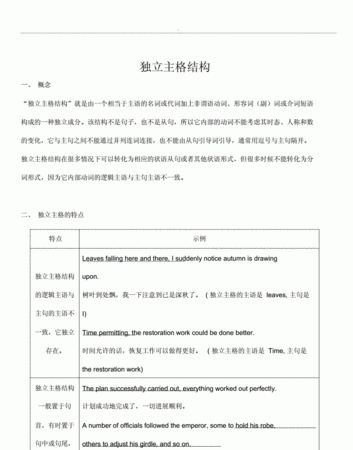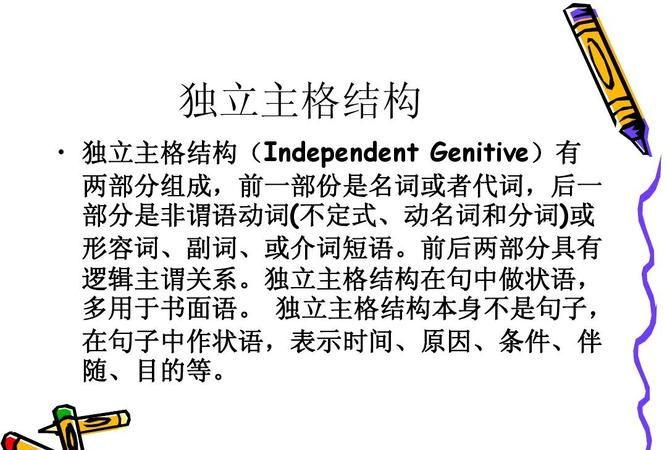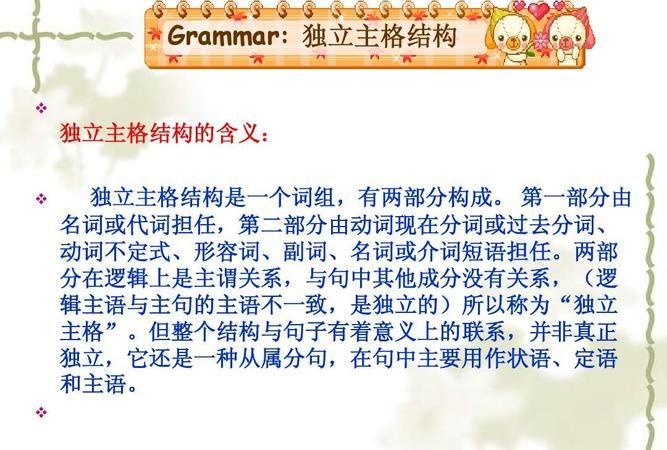本文目录
独立主格不定式和现在分词
英语的独立主格由“名词或代词+形容词、副词、分词不、不定式等”构成,其中的“名词或代词”用主格形式,起逻辑主语的作用,其后的“形容词、副词、分词不、不定式等”起逻辑谓语的作用。注意,独立主格结构与主句之间不能使用任何连接词。
在“名词/代词+动词不定式”这类独立主格结构中,动词不定式和它前面的名词或代词如果存在着逻辑上的主谓关系,动词不定式则用主动的形式;如果是动宾关系,则用被动形式。如:
We divided the work, he to dean the window and I to sweep the floor. 我们分了工,他擦窗户,我扫地。
A number of officials followed the emperor, some to hold his robe, others to adjust his girdle and so on. 许多官员尾随皇帝之后,有的拎着皇帝的衣袍,有的则给他整腰带,等等。
He is leaving for the conference next week, all expenses to be paid by his company. 他下周去参加一个会议,所有费用由他的公司支付。
The four of us agreed on a division of labor, each to translate a quarter of the book. 我们四人同意分工干,每人翻译全书的四分之一。
Many trees, flowers, and grass to be planted, our newly-built school will look even more beautiful. 种上许多的树、花和草后,我们新建的学校看上去将更美。
说白了,就是俩句子凑一块,之间没有连接词。主句有谓语,随从句的谓语被不定式代替。独立主格作为随从句中的主语,如果随从句中的动词和独立主格是主动关系,则to + V原, 若为被动,则to be + Vpp.
望采纳!

独立主格结构与哪类非谓语动词有关
是啊,动词不定式可以起到的状语成分有目的,结果等等,除此以外还可以表示将来的用法,你现在的这个句子就是用不定式表示将来充当状语

英语中的独立主格结构是什么意思
独立主格结构是由一个相当于主语的名词或代词加上非谓语动词、形容词(副)词、或介词短语构成的一种独立成分。该结构不是句子,也不是从句,所以它内部的动词不能考虑其时态、人称和数的变化,它与其主句之间既不能通过并列连词连接也不能有从句引导词引导,常用逗号与其主句隔开。独立主格结构在很多情况下可以转化为相应的状语从句或其他状语形式,但很多时候不能转化为分词形式,因为它内部动词的逻辑主语与主句主语不一致。在做这类题目时一定要小心判断,不能粗心大意。
一、独立主格结构的构成形式
独立主格结构的构成方式为:名词普通格或代词主格+现在分词/过去分词/不定式/名词/形容词/副词/介词短语等。使用独立主格结构是因为出现了与句子主语不一致的情况。
1. 名词或代词+现在分词
现在分词表示前面的名词或代词主动进行的动作或状态。如:
The man lay there, his hands trembling.
那个男子躺在那儿,双手在颤抖。
有时,现在分词being或having been在独立主格结构中可以省略。如:
The weather (being) fine,we decided to go swimming.
天气晴朗,我们决定去游泳。
2. 名词或代词+过去分词
过去分词表示前面的名词或代词被动完成的动作。如:
The girl sat there silent,her head bent low.
这姑娘一声不响,低着头坐在那里。
All things considered, her paper is of greater value than yours.
各方面考虑起来,她的论文比你的论文更要有价值一些。
3. 名词或代词+不定式(短语)
不定式表示将来的动作。如:
He suggested going for a picnic,Mary to provide the food.
他建议去野餐,由玛丽负责提供食物。
Time is pressing, two hours to go only.
时间紧迫,只剩两个小时了。
4. 名词或代词+名词(短语) 如:
Many people joined in the work, some of them women and children.
许多人参加了这项工作,其中一些人是妇女和儿童。
5. 名词或代词+形容词(短语)
形容词(短语)说明前面名词或代词的性质或状态。如:
The floor wet, we had to stay outside for a while.
地面很湿,我们只好在外面呆一会儿。
6. 名词或代词+副词
副词也多是说明前面名词或代词的状态。如:
The meeting over, we all went home.
会议结束了,我们都回家了。
7. 名词或代词+介词短语 如:
The teacher came in, a book in his hand.
老师进来了,手里拿着一本书。
有时,独立主格结构中名词前面的定语可以省略。如:
The boy lay silently on the grass, (his) eyes closed.
A girl was walking in the street, (a) flower in (her) hand.
二 独立主格结构的作用
1. 作状语
1) 表示时间 如:
Her homework done (=After her homework was done),Lucy decided to go shopping.
2) 表示原因 如:
There being no buses (Because there were no buses),we had to walk home.
3) 表示条件 如:
Weather permitting (If weather permits), we will go to play football.
4) 表示方式或伴随 如:
He rushed into the room, his face covered with sweat.
2. 作同位语 如:
There are two doors, one leading to the bedroom, the other (leading) to the kitchen.
三 独立主格前面有时可以加上介词with或without,构成介词的复合结构。这种结构在句中主要用作状语,也可用作定语。如:
He stood on the deck with his hand waving to us.(状语)
他站在甲板上向我们频频挥手。
He went out without a hat on his head.(状语)
他头上没戴帽子就出去了。
Do you know the girl with a bag on her back?(定语)
你认识那个后背上背包的女孩吗?
10.1 独立主格
(一): 独立主格结构的构成:
名词(代词)+现在分词、过去分词;
名词(代词)+形容词;
名词(代词)+副词;
名词(代词)+不定式;
名词(代词) +介词短语构成。
(二) 独立主格结构的特点:
1)独立主格结构的逻辑主语与句子的主语不同,它独立存在。
2)名词或代词与后面的分词,形容词,副词,不定 式,介词等是主谓关系。
3)独立主格结构一般有逗号与主句分开。
举例:
The test finished, we began our holiday.
= When the test was finished, we began our holiday.
考试结束了,我们开始放假。
The president assassinated, the whole country was in deep sorrow.
= After the president was assassinated, the whole country was in deep sorrow.
总统被谋杀了,举国上下沉浸在悲哀之中。
Weather permitting, we are going to visit you tomorrow.
如果天气允许,我们明天去看你。
This done, we went home.
工作完成后,我们才回家。
The meeting gone over, everyone tired to go home earlier.
会议结束后,每个人都想早点回家。
He came into the room, his ears red with cold.
他回到了房子里,耳朵冻坏了。
He came out of the library, a large book under his arm.
他夹着本厚书,走出了图书馆。

独立主格的本质
独立主格也会考虑到时间关系。但主要考虑的还是主被动关系。所以,除非明显地强调完成,或者进行,否则名词后根据主被动关系接doing或者done就可以了。

以上就是关于独立主格结构要考虑不定时嘛 ,独立主格不定式和现在分词的全部内容,以及独立主格结构要考虑不定时嘛 的相关内容,希望能够帮到您。

